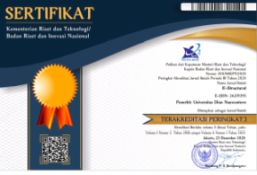The Appraisal of the Teacher’s Talk to Enhance Students’ Critical Thinking Skills Through Narrative Text in Design Thinking Pedagogy
Abstract
Design thinking has become a new trend at schools in different countries. There are many educators who are eager to adopt Design thinking as an effective strategy for helping their students to learn through solving real-world problems. For Indonesian context, Design Thinking provides a new innovative ground of teaching English in EFL setting. Teachers engage the students in collaborative problem solving, creative challenge, and foster social –emotional balance and stability. The paper portrays how the teacher conducts learning activities in the Empathy stage of Design Thinking to build students’ critical literacy from the start. The attitude domain of the appraisal theory is used to disclose the way of the teacher to guide the students to express their emotional reaction toward the story, to assess the behavior of the characters and construe the value of things in the text.
The classroom discourse analysis shows that the teacher’s talk by employing the attitude resources plays important role in supporting the students to develop their critical thinking capacity and build their narrative’s content knowledge.
The result of the study is expected to enrich the reference of appraisal discourse analysis theory and provide the example of the teaching practice for enhancing students’ critical thinking capacity in Narrative learning through Design Thinking pedagogy.
Full Text:
PDFReferences
Barrel, J.(2008). Did you ask a good question today in Pressien, B.Z.(eds). (2008). Teaching for intelligence. (2nd Edn). (Pp.101-110). California: Corwin Press a Sage Company. john barrel. Did you ask a good question today.
Bassham, G., Irwin, W., Nardone, H., and Wallace J.M. (2005). Critical thinking. A student’s introduction. (2nd Edn.). New York: Mc Graw Hill.
Bowell, T and Kemp, G. (2005).Critical thinking and a concise guide. (2nd Edn.).New York: Routledge.
Brown, T. (2008). Design Thinking. Harvard Business Review, pp. 1–10.
Chafee, J. (2000). Thinking Critically. (6th Edn). Boston: Houghton Mifflin Company.
Chahal, M. (2013). Lesson writing: Innovations in problem designing. European Scientific Journal, Vol.9/17, pp. 163-170. ISSN: 1857-7431.
Christie, F. (2005). Language education in the primary years. London: Continuum.
Christie, F., and Derewianka, B. (2008). School discourse. London: Continuum.
Christie, F. and Martin, J. R. (eds). (1997). Genre and Institutions: Social Processes in the Workplace and School. London: Cassell.
Droga, L., & Humphrey,S. (2003). Grammar and meaning. An introduction for primary teachers. Berry, NSW: Target Texts.
Emilia, E. (2010).Teaching writing. Developing critical learners. Bandung: Rizqi Press.
Feez, S., and Joyce, H. (1998). Writing skills. Narrative and nonfiction text types. Melbourne: Phoenix Education Pty. Ltd.
Fredrickson, C. (2017).Design thinking in ESL Programming: Creating A Program Model for newcomer students. School of Education Student Capstone Projects, 59, pp. 1-53. https://digitalcommpms.hamline.edu_cp/59.
Gibbons, P.(1991).Learning to learn in second language.NSW: Primary English teaching Association.
Gibbons, P. (2002). Scaffolding language and scaffolding learning. Teaching second language learners in the mainstream classroom. Pourthsmouth, NH: Heineman.
Gibbons, P.(2009). English Learners Academic Literacy and Thinking.Portsmouth, NH: Heinemann.
Halliday, M.A.K (1993). Towards a language based theory of learning. Linguistics and Education. 5, pp. 93-116.
Hammond, J.(eds). (2001).Scaffolding teaching and learning in language and literacy education. Sydney: Primary English teaching association
Kern, R. (2000). Literacy and language teaching. New York: Oxford University Press.
Knap, P and Watkins, M.(2005). Genre, Text , Grammar. Technologies for teaching and assessing writing.Sydney: UNSW press.
Koh, J. H. L., Chai, C. S., Wong, B., & Hong, H. Y. (2015). Design thinking and in-service teachers. In Design Thinking for Education, pp. 87-107. Singapore: Springer Singapore.
Leicester, M and Taylor, D. (2010). Critical thinking across the curriculum. Developing critical thinking skills, literacy and philosophy in the primary classroom. Bershire: Mc Graw Hill Companies.
Leverenz, C.S.(2014). Design thinking and the wicked problems of teaching writing. Computers and Composition, Vol. 33, pp. 1-12. doi: 10.1016/j.compcom.2014.07.001.
Martin, J.R., and Rose, D. (2007). Working with Discourse: meaning beyond the clause. (2nd Edn.). London: Continuum
Martin, J. R., and Rose, D. (2008). Genre Relations. Mapping Culture. London: Equinox.
Martin, J.R. & White P.R.R. (2005). The Language of Evaluation: Appraisal in English. New York: Palgrave MacMillan.
Menteri Pendidikan dan Kebudayaan Republik Indonesia.2016. Salinan Lampiran Peraturan Menteri Pendidikan dan Kebudayaan No. 22 tahun 2016 tentang Standar Proses Pendidikan dan Menengah. Kementerian Pendidikan dan Kebudayaan: Jakarta.
Mueller, J.(2009). Assesssing Critical skills.Ohio: Linworth Publishing, Inc.
Ponet, S. (2013). Using design thinking and inquiry in teaching literacy. The Knowledge Network for Innovations in Learning and Teaching (KNILT). Retrieved in 30 April 2018 from https://tccl.arcc.albany.edu/knilt/index.php/Using_Design-Thinking_and_Inquiry_in_Teaching_Literacy.
Reichhenbach, R.B.(2001).Introduction to Critical Thinking. New York: McGraw Hill.
Siegel, H.(1988). Educating reason. Rationality, critical thinking and education. New York: Routledge.
Wells, G. (1999). Dialogic inquiry. Towards a sociocultural practice and theory of education. Second Edition. Melbourne: Cambridge University Press.
DOI: https://doi.org/10.33633/es.v1i2.2144
Article Metrics
Abstract view : 686 timesPDF - 546 times
Refbacks
- There are currently no refbacks.
Accredited by:
Indexed by:
In Collaboration with:

This work is licensed under a Creative Commons Attribution 4.0 International License.

























